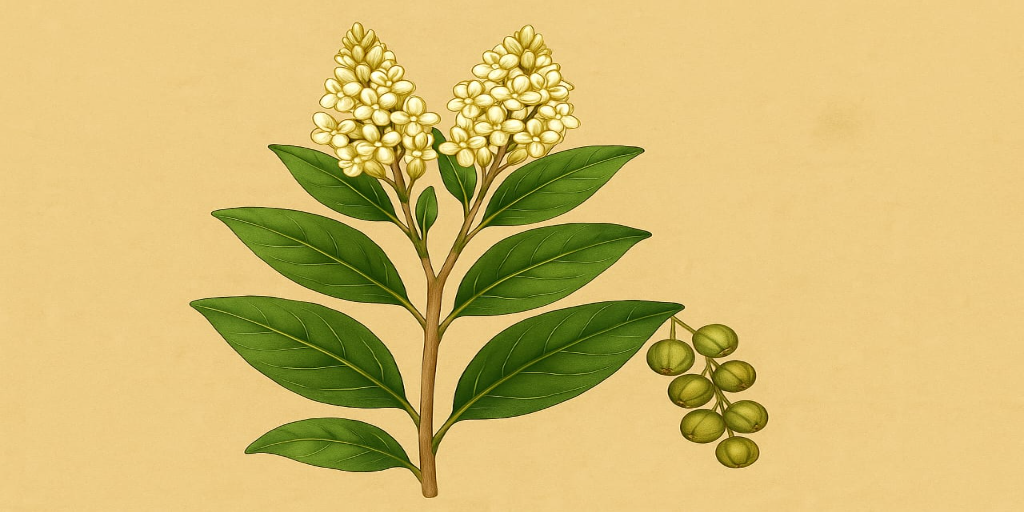Sanskrit Name: Madyantika
Devanagari Name: मेहंदी
Botanical Name: Lawsonia inermis
English Name: Henna
Description:
Mehendi, also known as Henna, represents joy, beauty, and sacred traditions within Hindu culture. It is grown for both cosmetic and medicinal uses, with every part of the plant (including the root, stem, leaves, flower pods, and seeds) holding significant medicinal value. The leaves are particularly important as they contain a coloring agent called Lawson, which is a red-orange dye molecule.
In addition to its cosmetic applications, Mehendi is commonly applied to the skin to alleviate various skin issues such as itching, allergies, rashes, and wounds, thanks to its antimicrobial and anti-inflammatory qualities. It is also advantageous for hair, serving as a natural dye, enhancing growth, conditioning, and adding shine.
Ayurveda endorses Mehendi for its healing properties (Ropan) and its cooling nature (Sita). When applied to the scalp, it helps absorb excess oil and keeps the area dry due to its astringent (Kashaya) and drying (Ruksha) characteristics, which can aid in controlling dandruff.
While fresh Mehendi leaves are safe for use, caution is advised with Mehendi powder from stores, especially for internal use, as it may contain chemicals that could trigger allergic reactions.
Benefits – through the lens of Ayurveda:
- Raktashodhaka (blood purifier)
- Pittahara (pacifies Pitta)
- Vranaropaka (wound healer)
- Keshya (good for hair)
Main Chemical Constituents:
- Lawsone
- Tannins
- Flavonoids (luteolin, apigenin)
Nutritional Components:
- Vitamin C (trace)
- Iron
- Calcium
- Magnesium
Medical Conditions(Relief):
- Mehendi, or henna, is a well-known remedy for headaches, fever, and skin issues such as eczema, sunburn, and acne.
- Its cooling properties make it beneficial for soothing inflammation in the body, and it is often used to relieve muscle pain and joint inflammation.
- Mehendi is also used for hair health, helping to treat dandruff, scalp irritation, and hair fall.
- It strengthens the hair follicles, promotes blood circulation to the scalp, and can enhance hair growth.
Medical Conditions(Avoid):
- Mehendi should be avoided by individuals with allergic reactions to henna or sensitive skin.
- It can cause skin irritation in some individuals, especially when applied in excess.
- Pregnant women should consult their healthcare provider before using henna, especially in the form of essential oils or during prolonged use.
References:
- Bhavaprakasa Nighantu of Sri Bhavamisra, commentary by Padmashri prof. K. C. Chunekar edited by Dr. G. S. Pandey. Chaukhambha Bharati Academy Varanasi. Reprint, 2015.
- Shastry JLN, Ayurvedoktha Aushadha Niruktamala (ed.1), Varanasi, Chawkambha Orienatlia, 2001; p.82
- Acharya YT, editor (5 ed.), Commentary Nibandha Sangraha on Sushruta samhita of Sushruta. Chikitsastana; Kushthachikitsa: Chapter 9, verse 34. Varanasi: Chaukambha Orientalia,1992; p 445
- Sharma PV, Dravyaguna Vijnana.ed.14. Varanasi: Chawkambha Bharati Academy; 1993: p 192
- Anoosha Adiga, Aditi Gandhi, Pradeep, Prakash L Hegde. Comprehensive review on Madayantika (Lawsonia inermis L.). J Ayurveda Integr Med Sci [Internet]. 2022Dec.9 [cited 2025Jun.23];7(10):204 -210.
- Chengaiah B, Rao Mallikarjuna, et al, Medicinal importance of natural dyes – A Review, International Journal of PharmTech Research, Vol.2, 2010, p. 144-54
- Rahman Bhuiyan, M.A., Ali, A., Islam, A. et al. Colouration of polyester fiber with natural dye henna (Lawsonia inermis L.) without using mordant: a new approach towards a cleaner production. Fash Text 5, 2 (2018).
- Singh DK, Luqman S, Lawsonia inermis L, – A commercially important primaeval dying and medicinal plant with diverse pharmacological activity: A review, Elsevier, .2015, p 269-86
- The Plant List (2010). Version 1. Published on the Internet

